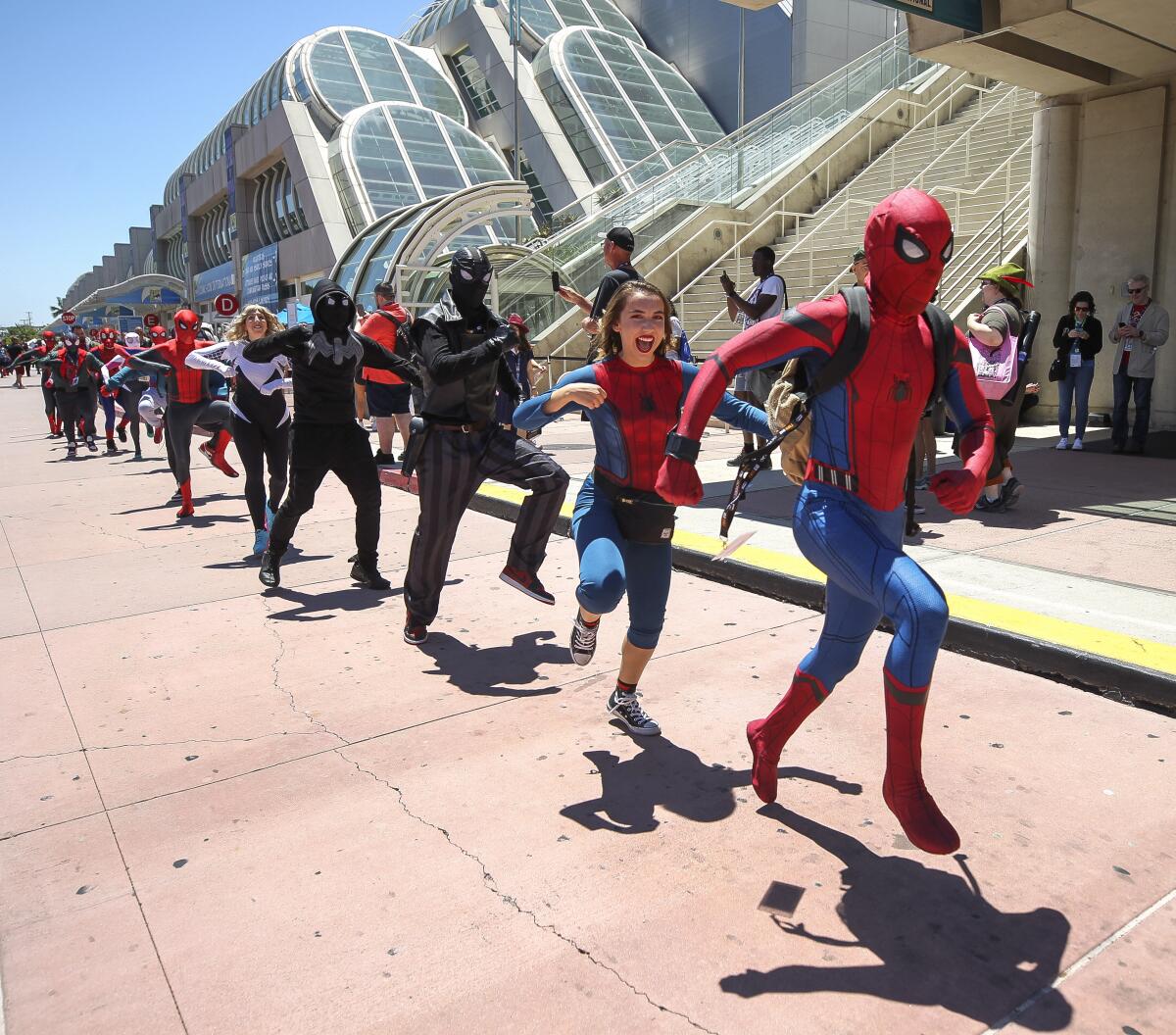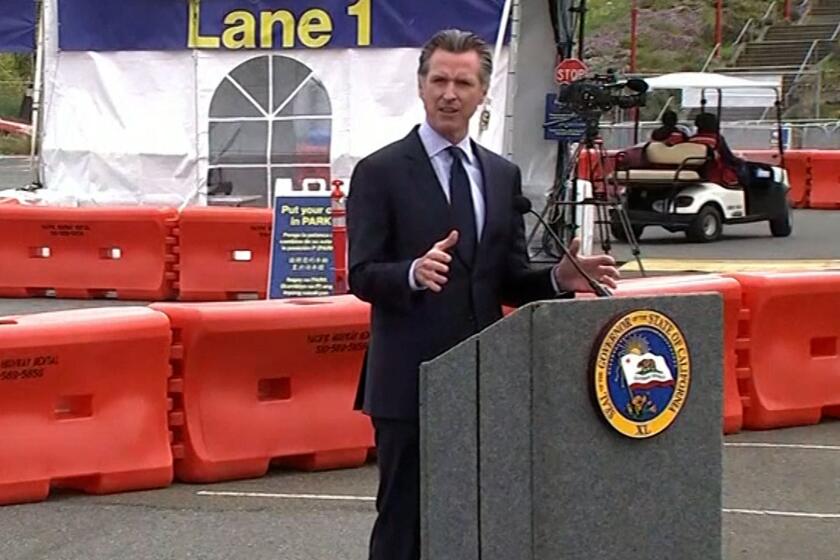Love Comic-Con or E3? It may take a while for huge crowds to return to conventions

- Share via
The San Diego Convention Center hosted about 135,000 visitors two years ago for Comic-Con, the four-day celebration of comic books and pop culture.
The National Assn. of Music Merchants drew 115,000 musical instrument dealers and distributors to the Anaheim Convention Center early last year.
The Los Angeles Convention Center welcomed 66,100 visitors to the Electronic Entertainment Expo, known as E3, in 2019.
With California aiming to lift most pandemic restrictions on June 15, convention center operators who have had to cancel hundreds of events, worth billions of dollars in revenue, say they are eager to once again host conventions and trade shows that draw visitors from across the country and around the globe.
After more than a year of coronavirus-related closures, California has a reopening date: June 15. Here are the basics.
But even when state restrictions lift, experts acknowledge, it may be a year or more before California convention centers host the kind of mega-crowds that flocked to Comic-Con, NAMM and E3 in past years.
“We anticipate that shows will be smaller starting off and getting back up to speed hopefully next year,” said Ellen Schwartz, general manager of the Los Angeles Convention Center. “As we get into the last quarter of this calendar year and start the new year, we’re hopeful that the business will come back to closer to where it was before the pandemic.”
Among the reasons for the smaller events: State officials say COVID-19 protocols for large-scale indoor events will still require testing or vaccination verifications, which could exclude some would-be attendees. The state has yet to release details of those requirements.
Also, surveys show that many business travelers still don’t feel safe meeting face to face indoors with thousands of strangers. Some elements of future events are likely to be conducted via streaming video, accommodating virus-cautious attendees who want to stay home.
The Centers for Disease Control and Prevention still recommends against attending large indoor gatherings, saying they increase the risk of spreading COVID-19.
Rachel “Kiko” Guntermann, a professional costume maker who previously attended five or six conventions a year, including Comic-Con, said she would not feel safe returning to a large convention even though she has been fully vaccinated against COVID-19.
“Conventions were a center of my life for a while, and now the idea of being in a vendor hall with that many people makes me want to dry heave,” she said.
In addition, restrictions on international travel may also limit the number of exhibitors and attendees for some conventions and trade shows. Some of the large organizations also need time to hire staff to arrange such large events.
“There will definitely be a ramp-up period after being closed for a year,” said Barbara Newton, president and chief executive of the California Travel Assn., a nonprofit organization that promotes tourism in the state. “We are convinced we will get there eventually.”
Confirmed guests for the Dec. 3-5 event at L.A.’s Convention Center include Zachary Levi, Tom Welling, Frank Miller, Tom Kenny and Giancarlo Esposito.
Even in states that have allowed conventions for the last several months, such as Nevada, Arizona and Florida, the events have been much smaller than those of the past, with safety protocols limiting attendance to only several hundred guests.
“We are not back to the mega-conventions yet,” said Brynne Frost, chief executive of Destination Concepts Inc., a San Diego company that before the pandemic managed about 250 events a year nationwide.
The pandemic has delivered a hard hit to the nation’s convention and trade show industry. In 2020, such events generated about $20 billion in direct spending in the U.S. — down from about $100 billion in 2019, which was the industry’s best year ever, said David DuBois, president and CEO of the International Assn. of Exhibitions and Events.
The L.A. Convention Center has had 134 events canceled and 45 postponed, costing the city nearly $600 million in spending at the center, nearby restaurants, hotels and shops, said Schwartz, who based the spending estimate on pre-pandemic attendance.
The Long Beach Convention Center has had 121 meetings and conventions canceled since the start of the pandemic, losing that city more than $157 million in spending, Long Beach officials said.
The Palm Springs Convention Center has had more than 400 events canceled, losing about $279 million in spending in the region since the start of 2020, Palm Springs officials said. Some of those events are now being held in states with less strict pandemic rules: Two rebooked in Arizona, one moved to Georgia and one moved to Missouri.
“It’s been very frustrating,” said Scott White, president and CEO of the Greater Palm Springs Convention & Visitors Bureau.
The American Public Transportation Assn., a nonprofit that advocates for public transit, announced last week — before California declared its goal of rolling back restrictions in mid-June — that it had canceled its Aug. 31 to Sept. 3 gathering at the Anaheim Convention Center and rescheduled the event for November in Orlando, Fla.
“The decision to relocate was necessary due to current California restrictions on large gatherings and the unpredictability of planning such a large event when it is unclear when these restrictions will ease,” the group said in a statement.
A coalition of convention center operators has been pressing the state for months to allow larger-scale events.
Last week, the state issued guidelines that allow indoor venues located in counties in the orange tier — the third-strictest rung of California’s color-coded reopening road map — to host up to 150 people if all attendees test negative for the coronavirus or show proof they’re fully vaccinated against COVID-19. In counties in the yellow tier, the least restrictive rung, the cap on attendance rises to 200 people.
All of Southern California is in the orange tier, with the exception of Santa Barbara County, which remains in the more restrictive red tier.
If vaccination and virus transmission rates remain on pace, then on June 15 the tier system will become moot as restrictions substantially relax throughout the state. Large-scale indoor gatherings such as conventions would be allowed with virus testing or vaccination verification, among other “common-sense public health policies,” the state said.
New coronavirus cases have been dropping in California and in many other states, but they’re rising in others, and surveys show that some Americans still feel uncomfortable attending indoor conventions and trade shows.
A March survey of about 1,000 Americans by marketing research firm Ipsos found that 59% believe returning to their pre-pandemic lifestyles would pose a large or moderate risk to their health.
Of those surveyed, 29% said they would return to in-person gatherings once they or everyone in their circle of friends and family is vaccinated. Meanwhile, 30% said they already had returned to in-person gatherings, 21% said they would do so when officials say it’s safe, and 20% said they didn’t know.
A survey of 1,000 technology professionals by association management company Innovatis Group last fall found that 60% said they would feel comfortable attending an in-person event in the second half of 2021, but just over half of those surveyed said the size of an event would affect their decision to attend even if appropriate safety precautions were taken.

Mega-conventions and trade shows have yet to come back even in states that already are allowing mass gatherings.
Las Vegas, one of the nation’s most popular convention destinations, recently confirmed the city’s first large conference and trade show since the start of the pandemic. The gathering of concrete and masonry professionals — World of Concrete — is planned for June 8 to 10.
The event was originally scheduled for January and had been expected to draw about 60,000 attendees. Nevada’s Department of Business and Industry approved a permit to allow up to 50% of the building capacity — 24,500 attendees — over the course of the three-day event.
The organizer of the event, Informa Markets, commissioned a survey of past attendees, finding that 80% said they were likely to attend in June.
In November, the National Oil Recyclers Assn. held a conference and trade show in Tucson attended by 120 people, down from as many as 400 attendees in the past, according to organizers.
Organizers said they limited the number of attendees so that people could sit six feet apart during seminars in the exhibit halls. The number of exhibitors for the trade show was also reduced from 50 to 16. The event eliminated breakout sessions to reduce interaction among conference attendees.
The gathering was not as profitable as it has been in years past, but it was still worthwhile, said Scott Parker, president of the event organizer, Amber Ridge.
“I’d rather make something than nothing,” he said.
More to Read
Inside the business of entertainment
The Wide Shot brings you news, analysis and insights on everything from streaming wars to production — and what it all means for the future.
You may occasionally receive promotional content from the Los Angeles Times.












